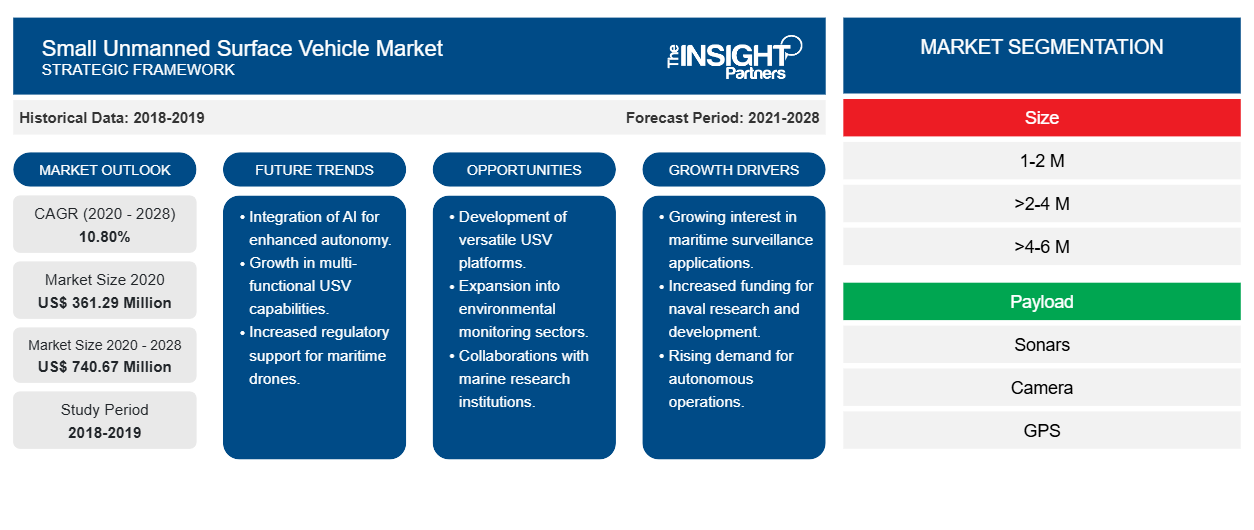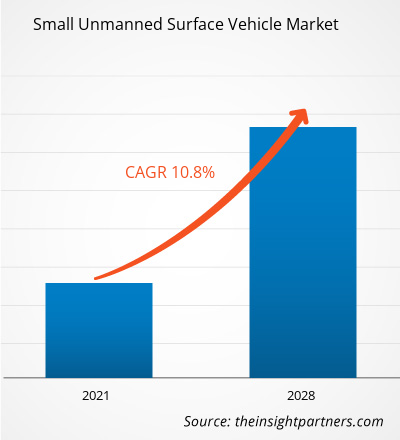[Research Report] The small unmanned surface vehicle market is expected to grow from US$ 361.29 million in 2021 to US$ 740.67 million by 2028; it is estimated to grow at a CAGR of 10.80% from 2021 to 2028.
Major factors such as the surge in the demand for ocean data mapping with water quality monitoring and rise in demand for coastal water patrol and anti-submarine warfare operations drive the growth of the small-unmanned surface vehiclesmarket. In addition, continuous investments in unmanned sea exploration technologies would generate huge opportunities for the market vendors during the forecast period. With the growth of coastal developments, the maritime domain is increasingly becoming congested, fueled by state and non-state actors using the sea for various activities. The warrants have a high emphasis on maritime surveillance and protection. Therefore, modern assets, such as unmanned vehicles, are deployed to reduce human life risks and mitigate enemy contacts by moving into other domains. Moreover, the surging application of digital connectivity acts as a major factor in the growth of unmanned oceanic systems. As connectivity plays a paramount role for the modern networked sea and sub-sea forces. The defense sectors in major countries are substantially investing in the development of connect subsea-based sensors, submerged platforms, and surface assets with air systems and space-based assets, as well as in cyber operations. This factor is anticipated to trigger the expanding operations of unmanned assets to counter any potential adversary threat. Thus, the continuous investments in the development of deep sea exploration technologies are expected to provide numerous profitable opportunities for the unmanned underwater vehicle and unmanned surface vehicle market players in the coming years.
Customize This Report To Suit Your Requirement
You will get customization on any report - free of charge - including parts of this report, or country-level analysis, Excel Data pack, as well as avail great offers and discounts for start-ups & universities
Small Unmanned Surface Vehicle Market: Strategic Insights

-
Get Top Key Market Trends of this report.This FREE sample will include data analysis, ranging from market trends to estimates and forecasts.
Impact of COVID-19 Pandemic on Small Unmanned Surface Vehicle Market
The COVID-19 pandemic hit almost all industries across the world in FY 2020 due to lockdown measures imposed by various countries. The restrictions disrupted the supply chain of different industries and generated a demand and supply gap in industries. Due to the pandemic, the reduction in the investments in automation technologies impacted negatively the small unmanned surface vehicles market in North America in 2020. However, the market is expected to regain its growth by the second quarter of 2022, according to a research study.
In terms of hydrography operations, the COVID-19 pandemic has not really heavily impacted the adoption of automation technologies. The marine industry operations were suspended during the first two quarters of 2020, which impacted the demand for unmanned surface vehicles across North America region. Also, the demand for unmanned systems has increased over the past few years, which has been become a trend across the marine industry operations. For instance, the defense sector has become one of the most growing markets for unmanned systems across North America, specifically in the US owing to the rising investments in the adoption of autonomous unmanned vehicles across defense industry. This factor has driven the small unmanned surface vehicles market growth in 2020.
Market Insights– Small Unmanned Surface Vehicle Market
Surge in Demand for Ocean Data Mapping and Water Quality Monitoring
An accurate map of the ocean bottom is necessary for navigation, transportation, fishery, telecommunication, and offshore energy, and to understand the ocean’s current and physical properties related to weather and climate. The long-range autonomous vehicle can map the ocean with an environment-friendly way. Also, an ocean data mapping with autonomous vehicle requires less manpower and costs than traditional ship-based mapping. Government organizations and private agencies are investing significantly in manufacturing and developing advanced and efficient small unmanned surface vehicles for ocean data mapping. Therefore, there is an increasing global demand for small USVs. These vehicles are used in various applications, such as ocean data collection and mapping, water quality monitoring, and shallow waters and ports protection.
Water pollution is an acute problem, especially in developing countries. Therefore, water quality monitoring has become crucial for water protection. With the rapid development of industry and urbanization, industrial and sanitary sewage has severely affected fresh-water sources worldwide, especially in developing countries. It has significantly influenced the living conditions of human beings. New measurement technologies, such as ship-borne measurements and IoT system, are used to monitor water quality.
Size-Based Insights
Based on size, the small unmanned surface vehicle market is segmented into 1–2 M, >2–4 M, and >4–6 M. The 1-2 M segment held the largest market share in 2021.
Players operating in the small unmanned surface vehicles market are mainly focused on the development of advanced and efficient products.
- In May 2021, Seabed announced a new dealership with Waterlinked. Waterlinked is well known for the world’s smallest DVL and their underwater GPS and Subsea modems.
- In January 2021, Seabed announced a new dealership with Hemisphere and become the official Hemisphere Distributor in the Benelux. Hemisphere GNSS has become a leader in the high-performance satellite positioning and heading marketplace with a robust technology foundation.
The regional trends and factors influencing the Small Unmanned Surface Vehicle Market throughout the forecast period have been thoroughly explained by the analysts at The Insight Partners. This section also discusses Small Unmanned Surface Vehicle Market segments and geography across North America, Europe, Asia Pacific, Middle East and Africa, and South and Central America.
Small Unmanned Surface Vehicle Market Report Scope
| Report Attribute | Details |
|---|---|
| Market size in 2020 | US$ 361.29 Million |
| Market Size by 2028 | US$ 740.67 Million |
| Global CAGR (2020 - 2028) | 10.80% |
| Historical Data | 2018-2019 |
| Forecast period | 2021-2028 |
| Segments Covered |
By Size
|
| Regions and Countries Covered |
North America
|
| Market leaders and key company profiles |
|
Small Unmanned Surface Vehicle Market Players Density: Understanding Its Impact on Business Dynamics
The Small Unmanned Surface Vehicle Market is growing rapidly, driven by increasing end-user demand due to factors such as evolving consumer preferences, technological advancements, and greater awareness of the product's benefits. As demand rises, businesses are expanding their offerings, innovating to meet consumer needs, and capitalizing on emerging trends, which further fuels market growth.

- Get the Small Unmanned Surface Vehicle Market top key players overview
The well completion market has been segmented as follows:
Small Unmanned Surface Vehicle Market – by Size
- 1–2 M
- >2–4 M
- >4–6 M
Small Unmanned Surface Vehicle Market – by Payload
- Sonar
- Camera
- GPS
- SATCOM
- Others
Small Unmanned Surface Vehicle Market – by Application
- Defense
- Scientific Research
- Disaster Management
- Hydrography
- Others
Small Unmanned Surface Vehicle Market – by Geography
- North America
- US
- Canada
- Mexico
- Europe
- Germany
- France
- Italy
- UK
- Russia
- Rest of Europe
- Asia Pacific (APAC)
- China
- India
- Japan
- South Korea
- Thailand
- Rest of APAC
- Middle East and Africa
- South Africa
- Rest of MEA
- South America
- Brazil
- Argentina
- Rest of SAM
Small Unmanned Surface Vehicle Market – Company Profiles
- HYDRONALIX
- Aanderaa Data Instruments AS
- AutoNaut Ltd
- Eco Marine Power
- Liquid Robotics, Inc
- OceanAlpha Group Ltd
- Seabed BV
- SeaRobotics Corporation
- Sirehna
- QinetiQ Group plc
Frequently Asked Questions
Which are the major companies operating in the small unmanned surface vehicle market?
Which region has dominated the small unmanned surface vehicle market in 2020?
Which application dominated the market in 2020?
What are key driving factors behind small unmanned surface vehicle market growth?
What are key market opportunities for small unmanned surface vehicle market?
- Historical Analysis (2 Years), Base Year, Forecast (7 Years) with CAGR
- PEST and SWOT Analysis
- Market Size Value / Volume - Global, Regional, Country
- Industry and Competitive Landscape
- Excel Dataset
Recent Reports
Related Reports
Testimonials
Reason to Buy
- Informed Decision-Making
- Understanding Market Dynamics
- Competitive Analysis
- Identifying Emerging Markets
- Customer Insights
- Market Forecasts
- Risk Mitigation
- Boosting Operational Efficiency
- Strategic Planning
- Investment Justification
- Tracking Industry Innovations
- Aligning with Regulatory Trends





















 Get Free Sample For
Get Free Sample For